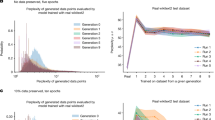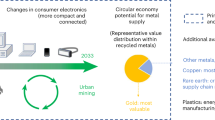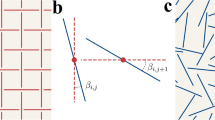Abstract
Generative artificial intelligence (GAI) requires substantial computational resources for model training and inference, but the electronic-waste (e-waste) implications of GAI and its management strategies remain underexplored. Here we introduce a computational power-driven material flow analysis framework to quantify and explore ways of managing the e-waste generated by GAI, with a particular focus on large language models. Our findings indicate that this e-waste stream could increase, potentially reaching a total accumulation of 1.2–5.0 million tons during 2020–2030, under different future GAI development settings. This may be intensified in the context of geopolitical restrictions on semiconductor imports and the rapid server turnover for operational cost savings. Meanwhile, we show that the implementation of circular economy strategies along the GAI value chain could reduce e-waste generation by 16–86%. This underscores the importance of proactive e-waste management in the face of advancing GAI technologies.
This is a preview of subscription content, access via your institution
Access options
Access Nature and 54 other Nature Portfolio journals
Get Nature+, our best-value online-access subscription
$32.99 / 30 days
cancel any time
Subscribe to this journal
Receive 12 digital issues and online access to articles
$119.00 per year
only $9.92 per issue
Buy this article
- Purchase on SpringerLink
- Instant access to full article PDF
Prices may be subject to local taxes which are calculated during checkout


Similar content being viewed by others
Data availability
This paper analyzes existing and publicly available data. All data sources used in this research are referenced in the main text or in Supplementary Information17. Source data for Figs. 1b,c and 2b,c are available with this paper.
Code availability
The main code of our approach (as well as datasets to run the code) is available17.
References
Crawford, K. Generative AI’s environmental costs are soaring—and mostly secret. Nature 626, 693 (2024).
Singhal, K. et al. Large language models encode clinical knowledge. Nature 620, 172–180 (2023).
Grossmann, I. et al. AI and the transformation of social science research. Science 380, 1108–1109 (2023).
Jia, Z. et al. The importance of resource awareness in artificial intelligence for healthcare. Nat. Mach. Intell. 5, 687–698 (2023).
Lannelongue, L. et al. GREENER principles for environmentally sustainable computational science. Nat. Comput. Sci. 3, 514–521 (2023).
Mytton, D. & Ashtine, M. Sources of data center energy estimates: a comprehensive review. Joule 6, 2032–2056 (2022).
Masanet, E., Shehabi, A. & Koomey, J. Characteristics of low-carbon data centres. Nat. Clim. Change 3, 627–630 (2013).
Computing 2030: Building a Fully Connected, Intelligent World (Huawei, 2021).
Baldé, C. P., et al. Global E-waste Monitor 2024 (ITU/UNITAR, 2024); https://ewastemonitor.info/the-global-e-waste-monitor-2024/
Parvez, S. M. et al. Health consequences of exposure to e-waste: an updated systematic review. Lancet Planet. Health 5, e905–e920 (2021).
Data Centres and Data Transmission Networks https://www.iea.org/energy-system/buildings/data-centres-and-data-transmission-networks (IEA, 2023).
Ambrogio, S. et al. An analog-AI chip for energy-efficient speech recognition and transcription. Nature 620, 768–775 (2023).
Wen, W. et al. Learning structured sparsity in deep neural networks. In Proc. 30th International Conference on Neural Information Processing Systems 2082–2090 (Curran, 2016).
Jonathan, O. Who’s making chips for AI? Chinese manufacturers lag behind US tech giants. Nature https://doi.org/10.1038/d41586-024-01292-1 (2024).
Nuss, P. & Eckelman, M. J. Life cycle assessment of metals: a scientific synthesis. PLoS ONE 9, e101298 (2014).
Walden, J., Angelika, S. & Maroye, M. Digital product passports as enabler of the circular economy. Chem. Ing. Tech. 93, 1717–1727 (2021).
Johnly233. E-waste-Challenges-of-Generative-Artificial-Intelligence: revised version (V1.1). Zenodo https://doi.org/10.5281/zenodo.13790035 (2024).
Acknowledgements
This research was financially supported by the National Natural Science Foundation of China (72274187 to P.W., 71961147003 to W.-Q.C.) and CAS IUE Research Program (IUE-JBGS-202202 to P.W.). We thank E. Masanet and our other colleagues for their contributions, which have improved this study.
Author information
Authors and Affiliations
Contributions
P.W. and L.-Y.Z. designed the research; L.-Y.Z., P.W. and A.T. led the drafting of the manuscript. P.W., L.-Y.Z. and W.-Q.C. contributed to the methodology; L.-Y.Z., P.W. and A.T. interpreted the results. All authors contributed to the final writing of the article.
Corresponding authors
Ethics declarations
Competing interests
The authors declare no competing interests.
Peer review
Peer review information
Nature Computational Science thanks Loïc Lannelongue, Mengmeng Wang and the other, anonymous, reviewer(s) for their contribution to the peer review of this work. Primary Handling Editor: Kaitlin McCardle, in collaboration with the Nature Computational Science team.
Additional information
Publisher’s note Springer Nature remains neutral with regard to jurisdictional claims in published maps and institutional affiliations.
Supplementary information
Supplementary Information
Supplementary Discussion, Figs. 1–8, Tables 1–4 and equations 1–7.
Supplementary Data 1
Table of studied scenarios, giving a brief description and key parameter configurations for each scenario studied in the main text.
Source data
Source Data Fig. 1
Statistical source data.
Source Data Fig. 2
Statistical source data.
Rights and permissions
Springer Nature or its licensor (e.g. a society or other partner) holds exclusive rights to this article under a publishing agreement with the author(s) or other rightsholder(s); author self-archiving of the accepted manuscript version of this article is solely governed by the terms of such publishing agreement and applicable law.
About this article
Cite this article
Wang, P., Zhang, LY., Tzachor, A. et al. E-waste challenges of generative artificial intelligence. Nat Comput Sci 4, 818–823 (2024). https://doi.org/10.1038/s43588-024-00712-6
Received:
Accepted:
Published:
Issue date:
DOI: https://doi.org/10.1038/s43588-024-00712-6
This article is cited by
-
Radiology AI and sustainability paradox: environmental, economic, and social dimensions
Insights into Imaging (2025)
-
Modeling the increase of electronic waste due to generative AI
Nature Computational Science (2024)



